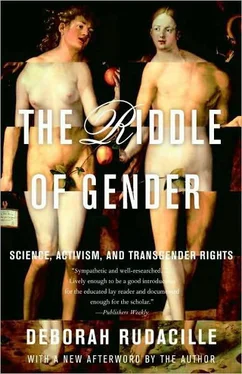HBIGDA recognised the use of private practitioners Meyerowitz, How Sex Changed, 273.
Six CHILDHOOD, INTERRUPTED
I wonder what my parents imagined would happen to me in a mental hospital Daphne Scholinski, The Last Time I Wore a Dress (New York: Riverhead Books, 1997), 6.
Defining a mental disorder Herb Kutchins and Stuart A. Kirk, Making Us Cray: DSM — The Psychiatric Bible and the Creation of Mental Disorders. (New York: Free Press, 1997), 27.
As early as i<)56, the psychologist Evelyn Hooker Evelyn Hooker, “The Adjustment of the Male Overt Homosexual,” Journal of Projective Techniques 21 (1957): 18—31; Evelyn Hooker, “Male Homosexuality in the Rorschach,” Journal of Projective Techniques 22 (1958): 33—54.
The deletion of homosexuality from the manual See “The Fall and Rise of Homosexuality,” in Kutchins and Kirk, Making Us Cravj, 55—100, a discussion of the political activism and internal debate in the American Psychiatric Association that led to the deletion of the diagnosis.
DSM is the psychotherapist’s password for insurance coverage Kutchins and Kirk, Making Us Cravj, 12.
“transsexualism” first appeared as a diagnostic category American Psychiatric Association, Diagnostic and Statistical Manual of Mental Disorders, 3rd ed. (Washington, D.C.: American Psychiatric Association, 1980).
due to inexperience and naivete Norman Fisk, M.D., “Gender Dysphoria Syndrome: The How, What, and Why of a Disease,” in Proceedings of the Second Interdisciplinary Symposium on Gender Dysphona Syndrome, eds. Donald R. Laub, M.D, and Patrick S. Gandy, M.S., Stanford University Medical Center, February 2-4,1973, 8. The symposium was sponsored by the divisions of Urology and Plastic and Reconstructive Surgery at the Stanford School of Medicine. Laub, a surgeon, and Fisk, a psychiatrist, were the primary architects of the Stanford Gender Identity Clinic. See also D. R. Laub and N. Fisk, “A Rehabilitation Program for Gender Dys phoria Syndrome by Surgical Sex Change,” Plastic and Reconstructive Surgery 53, no. 4 (April 1974): 388-403. For a consumer’s perspective on the Stanford program, see Dawn Levy, “Two Transsexuals Reflect on University’s Pioneering Gender Dysphoria Program.” Levy describes the experience of Sandy Stone and Jamison Green in the program. Stanford Online Report. Downloaded on July 18, 2001, from http://wwwStanford.edu/dept/news/report/news/may3/sexhange-53-html.
We avidly searched for those patients who, if admitting to homosexual behavior at all Fisk, “Gender Dysphoria Syndrome,” 8.
intensely and abidingly uncomfortable in their anatomic and genetic sex Ibid., 10. Fisk admits that “the vast majority of patients who qualify for primary diagnosis of gender dysphoria syndrome, as opposed to transsex- ualism, are people who themselves rush to embrace the diagnosis of trans- sexualism.” He attributes this to the fact that “both homosexuality and transvestism are still affectively experienced by many of our patients and their families as painful and inexcusable moral perversions or fetishes,” im plying that a diagnosis of transsexualism was not, at that time, perceived in the same manner by the patients themselves or their families (14). See also Laub and Fisk, “Rehabilitation Program;” and Norman M. Fisk, “Five Spectacular Results,” Archives of Sexual Behavior 7, no. 4 (1978).
In 1994, the diagnosis of transsexualism was deleted American Psychiatric Association Diagnostic and Statistical Manual of Mental Disorders, 4th ed. (Washington, D.C.: American Psychiatric Association, 1994).
a strong and persistent cross-gender identification Diagnostic criteria for gender identity disorder of childhood, from Diagnostic and Statistical Manual of Mental Disorders, 4th ed. (American Psychological Association, 1994).
Behaviors that would be ordinary or even exemplary for gender conforming boys and girls Katharine Wilson, Ph.D., “Gender Identity Disorder in Children,” http://www.gidreform.org, 3.
Recent revisions of the DSM Katherine Wilson, Ph.D., “The Disparate Classification of Gender and Sexual Orientation in American Psychiatry,” presented at the 1998 Annual Meeting of the American Psychiatric Association,” retrieved from http://www.gidreform.org, March 31,2001; Katherine Wilson, Ph.D., “Gender as Illness: Issues of Psychiatric Classification,” in Taking Sides — Clashing Views on Controversial Issues in Sex and Gender, E. Paul, ed. (Guilford, Conn.: Dushkin McGraw-Hill, 2000), 31-38. Retrieved from http://www.gidreform.org. See also Justin Cascio, “Bias in Writings on Gender Identity Disorder,” retrieved from TransHealth.com 1, no. 4 (Spring 2002). http://www.trans-health.com/Iss4voL1/research.htm.
boys diagnosed with GID in childhood “The most extensive and detailed of 199 prospective studies was carried out by Richard Green, a psychiatrist at UCLA. In his study, about four-fifths of the markedly effeminate boys became rather conventional homosexual or bisexual men, one boy became a transsexual man, and the remainder became heterosexual men…. Thus the association between childhood gender nonconformity and adult homosexuality is well established, especially in men,” LeVay, Queer Science, 98, discussing Richard Green, The “Sissy Boy Syndrome” and the Development of Homosexuality (New Haven: Yale University Press, 1987).
This conclusion has been disputed more recently by some clinicians who treat children and adolescents, for example, Peggy T. Cohen-Kettenis, Ph.D., Department of Child and Adolescent Psychiatry, University Medical Center, Utrecht, Netherlands. “Our data show that GID in childhood is associated with more than just one long-term trajectory. Continuation of GID into adolescence by no means seems to be a rare exception. We believe that treatment should be available for all children, regardless of their eventual sexual orientation, and should depend only on the severity of suffering experienced by the child.” In the Netherlands, adolescent children are eligible for hormone treatment if they meet the clinic’s criteria. Cohen-Kettenis notes that of seventy-four children referred to the clinic before the age of twelve, “17 intensely gender dysphoric adolescents applied for sex reassignment…. Of the 17, 3 adolescents have started cross-hormone treatment.” Peggy T. Cohen-Kettenis, “Gender Identity Disorder in DSM?” Letter, Journal ofthe Amencan Academy of Childhood and Adolescent Psychiatry 40, no. 4 (April 2001): 391.
American psychiatric perceptions ofetiology, distress, and treatment goals for transgenderedpeople Wilson, “Disparate Classification,” 9.
No single group has gone more unnoticed by society Gianna E. Israel and Donald E. Tarver II, M.D., Transgender Care: Recommended Guidelines, Practical Information and Personal Accounts (Philadelphia: Temple University Press, 1997), 132.
If there is any cure for children or youth with gender-identity issues Ibid., 137.
Parents with resources large or small will spend their last penny Ibid., 134.
Because gender-identity conflicts are still perceived as a mental health disorder Ibid.
or… out on the streets A study of homeless LGBT youths published in the American Journal of Public Health in 2002 concludes that “homeless youths who identify themselves as members of sexual minority groups are at increased risk for negative outcomes” such as “greater vulnerability to physical and sexual victimization, higher rates of addictive substance abuse, more psychopathology, and riskier sexual behavior in comparison with homeless heterosexual adolescents.” Bryan N. Cochran, Angela J. Stewart, Joshua A. Ginzler, and Ana Mari Cauce, “Challenges Faced by Homeless Sexual Minorities: Comparison of Gay, Lesbian, Bisexual, and Transgender Homeless Adolescents with their Heterosexual Counterparts,” American Journal of Public Health 92, no. 5 (May 2002): 773—77.
Читать дальше












